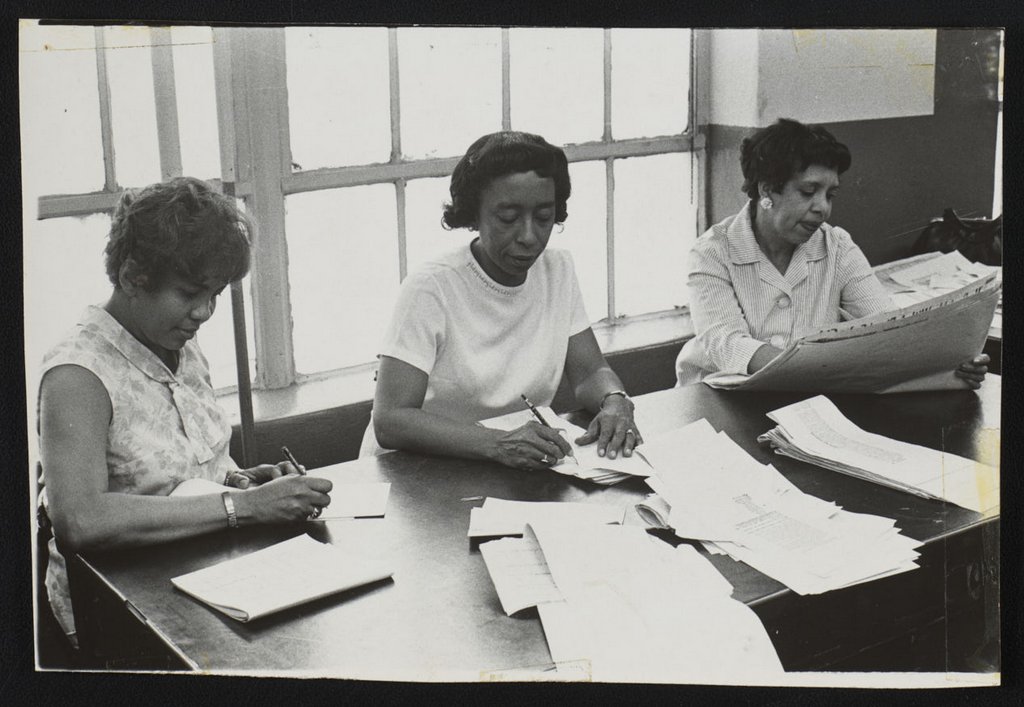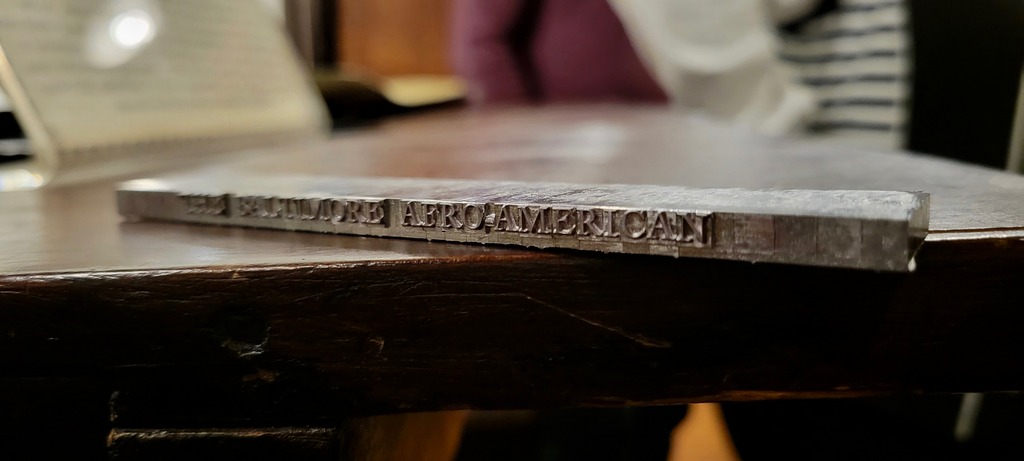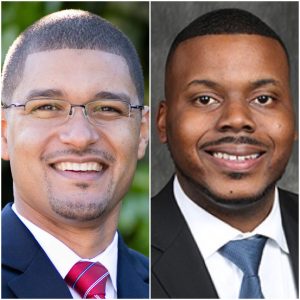#NNPA BlackPress
From Cold Type to The Digital Arena: A Salute to Denise Dorsey
NNPA NEWSWIRE — Though the tsunami of tech innovation left no part of the globe untouched, Denise Dorsey rode the wave into a media production career that has stretched five decades. She is now among the millions of baby boomers who met the evolution of technology and didn’t back down– in fact– she excelled.
The post From Cold Type to The Digital Arena: A Salute to Denise Dorsey first appeared on BlackPressUSA.

By Ron Taylor, Special to the AFRO and Alexis Taylor, AFRO News Editor
When Denise Dorsey entered the world of journalism production, ideas and images were transferred from writers’ typewriters to a printed page in a belabored process that dated back centuries. Now, thoughts surface on a palm-sized device and production teams can send entire publications to a printer with the click of a button.
Though the tsunami of tech innovation left no part of the globe untouched, Dorsey rode the wave into a media production career that has stretched five decades. She is now among the millions of baby boomers who met the evolution of technology and didn’t back down– in fact– she excelled.
When Dorsey started at the AFRO, the production process was more than a bit laborious. The dedication and persistence it took to produce even one edition of the paper was nothing short of an act of love for Black press to keep Black Americans informed.
The AFRO, like all printed publications of the day, used a system of hot type in the 1900s and cold type in the 20th century. Baltimoreans can take a look at the hot type process by visiting the Baltimore Museum of Industry, where hot type demonstrations take place as part of an exhibit that includes items from the AFRO American Newspapers.
In the late 1800s the most widely used production process included pressing molten metal into forms that created letters of the alphabet. The letters were then put together to compose words that would eventually be inked and printed onto paper. This was considered “hot type.”

In 1976 the AFRO didn’t have digital spell check– they had (from left to right) Mesdames Bertha Jordan, Beatrice Wilson, proof room forelady, and Eva Barnes. Together they served the AFRO for a total of 60 years and made sure each page was free of errors. (AFRO File Photo)
According to the University of Dayton in Ohio, cold type “refers to any method of type composition other than hot type. Type is cold because hot lead is not used.”
Today’s production process is completely digital, but Dorsey clearly recalls the processes of days gone by.
“Cold type was when they were actually typing things into a machine. It would come out in long strips of paper that they would send to the production floor,” remembers Dorsey. “They would actually paste it up on the templates. We had templates like the template that we use now in the computer.”
It took a mighty team to make sure each article got onto the page correctly- and then there was the challenge of photographs.
“We had a dark room then, so, of course, there was no digital. The photographers had negatives and they had to be processed.”
Once all of the pages for all of the unique editions of the AFRO were put together, a courier then had to come to the building, physically pick up the pages and take them to a printer.
Though she now is responsible for creating the cover and layout of the paper with production assistant Mishana Matthews, Dorsey started off in a smaller, but yet, important role.
“When I first came in 1976, I was only working on the advertising side. My job was marking up ads to send down to the typesetter.”

The AFRO American Newspapers is part of a permanent exhibit at the Baltimore Museum of Industry. Visitors can see how the newspaper was put together from start to finish with the process of “hot type,” a method that involved molding each letter printed on the page from molten metal. (Photo by Alexis Taylor)
Dorsey eventually became more involved with creating the pages that kept Black readers informed up and down the East Coast and beyond. Before long, she began helping the production team fill templates by pasting the articles and photographers together.
Today, Dorsey is no longer pasting together strips of paper to create each edition of the AFRO. In the 1990s the company began using computers in the production process. With the help of two dedicated AFRO women, and others in the production department, she learned how to use digital platforms to create each page.
“They were instrumental in teaching me InDesign when we began using that instead of Quark. Both were great graphic designers and I learned a lot from them,” said Dorsey. “It would be remiss of me to not acknowledge all those who helped me.”
Aside from in-house support, AFRO administrators sent their production team to the Maryland Institute College of Art to learn the finer points of producing a newspaper with new technology. They also had training from the Maryland, Delaware and D.C. Press Association.
Dorsey said mastering technology on the production side of the newspaper business was key in surviving the tech evolution. She said mentors helped her hone her computer skills, which have paid off to this day.
“It kept me there while other positions were starting to be eliminated,” said Dorsey. “One of the women who was there in the early 2000s helped set up the transition of us sending the pages electronically and no longer needing a courier.”
When asked how she views the ever-evolving nature of technology in the newspaper industry, Dorsey expressed mixed feelings.
“It’s not a bad thing, it just means that’s the future. When computers came in there were people who were upset. I wouldn’t want to go back to how we were doing the paper, but a lot of people lost their jobs,” she said.
Aside from InDesign, other graphic design and production applications Dorsey and Matthews use today are Photoshop and on occasion, Acrobat.
“I find it very interesting to see everything that is available and what is coming in the future,” said Dorsey. If the past is any indicator– she’ll be mastering what’s on the digital horizon too.
Dorsey says she will retire soon, but hopefully the AFRO team can talk her out of it.
The post “From cold type to the digital arena: a salute to Denise Dorsey,” appeared first on AFRO American Newspapers.
The post From Cold Type to The Digital Arena: A Salute to Denise Dorsey first appeared on BlackPressUSA.
#NNPA BlackPress
Chavis and Bryant Lead Charge as Target Boycott Grows
BLACKPRESSUSA NEWSWIRE — Surrounded by civil rights leaders, economists, educators, and activists, Bryant declared the Black community’s power to hold corporations accountable for broken promises.

By Stacy M. Brown
BlackPressUSA.com Senior National Correspondent
Calling for continued economic action and community solidarity, Dr. Jamal H. Bryant launched the second phase of the national boycott against retail giant Target this week at New Birth Missionary Baptist Church in Atlanta. Surrounded by civil rights leaders, economists, educators, and activists, Bryant declared the Black community’s power to hold corporations accountable for broken promises. “They said they were going to invest in Black communities. They said it — not us,” Bryant told the packed sanctuary. “Now they want to break those promises quietly. That ends tonight.” The town hall marked the conclusion of Bryant’s 40-day “Target fast,” initiated on March 3 after Target pulled back its Diversity, Equity, and Inclusion (DEI) commitments. Among those was a public pledge to spend $2 billion with Black-owned businesses by 2025—a pledge Bryant said was made voluntarily in the wake of George Floyd’s murder in 2020.“No company would dare do to the Jewish or Asian communities what they’ve done to us,” Bryant said. “They think they can get away with it. But not this time.”
The evening featured voices from national movements, including civil rights icon and National Newspaper Publishers Association (NNPA) President & CEO Dr. Benjamin F. Chavis Jr., who reinforced the need for sustained consciousness and collective media engagement. The NNPA is the trade association of the 250 African American newspapers and media companies known as The Black Press of America. “On the front page of all of our papers this week will be the announcement that the boycott continues all over the United States,” said Chavis. “I would hope that everyone would subscribe to a Black newspaper, a Black-owned newspaper, subscribe to an economic development program — because the consciousness that we need has to be constantly fed.” Chavis warned against the bombardment of negativity and urged the community to stay engaged beyond single events. “You can come to an event and get that consciousness and then lose it tomorrow,” he said. “We’re bombarded with all of the disgust and hopelessness. But I believe that starting tonight, going forward, we should be more conscious about how we help one another.”
He added, “We can attain and gain a lot more ground even during this period if we turn to each other rather than turning on each other.” Other speakers included Tamika Mallory, Dr. David Johns, Dr. Rashad Richey, educator Dr. Karri Bryant, and U.S. Black Chambers President Ron Busby. Each speaker echoed Bryant’s demand that economic protests be paired with reinvestment in Black businesses and communities. “We are the moral consciousness of this country,” Bryant said. “When we move, the whole nation moves.” Sixteen-year-old William Moore Jr., the youngest attendee, captured the crowd with a challenge to reach younger generations through social media and direct engagement. “If we want to grow this movement, we have to push this narrative in a way that connects,” he said.
Dr. Johns stressed reclaiming cultural identity and resisting systems designed to keep communities uninformed and divided. “We don’t need validation from corporations. We need to teach our children who they are and support each other with love,” he said. Busby directed attendees to platforms like ByBlack.us, a digital directory of over 150,000 Black-owned businesses, encouraging them to shift their dollars from corporations like Target to Black enterprises. Bryant closed by urging the audience to register at targetfast.org, which will soon be renamed to reflect the expanding boycott movement. “They played on our sympathies in 2020. But now we know better,” Bryant said. “And now, we move.”
#NNPA BlackPress
The Department of Education is Collecting Delinquent Student Loan Debt
BLACKPRESSUSA NEWSWIRE — the Department of Education will withhold money from tax refunds and Social Security benefits, garnish federal employee wages, and withhold federal pensions from people who have defaulted on their student loan debt.

By April Ryan
Trump Targets Wages for Forgiven Student Debt
The Department of Education, which the Trump administration is working to abolish, will now serve as the collection agency for delinquent student loan debt for 5.3 million people who the administration says are delinquent and owe at least a year’s worth of student loan payments. “It is a liability to taxpayers,” says White House Press Secretary Karoline Leavitt at Tuesday’s White House Press briefing. She also emphasized the student loan federal government portfolio is “worth nearly $1.6 trillion.” The Trump administration says borrowers must repay their loans, and those in “default will face involuntary collections.” Next month, the Department of Education will withhold money from tax refunds and Social Security benefits, garnish federal employee wages, and withhold federal pensions from people who have defaulted on their student loan debt. Leavitt says “we can not “kick the can down the road” any longer.”
Much of this delinquent debt is said to have resulted from the grace period the Biden administration gave for student loan repayment. The grace period initially was set for 12 months but extended into three years, ending September 30, 2024. The Trump administration will begin collecting the delinquent payments starting May 5. Dr. Walter M. Kimbrough, president of Talladega College, told Black Press USA, “We can have that conversation about people paying their loans as long as we talk about the broader income inequality. Put everything on the table, put it on the table, and we can have a conversation.” Kimbrough asserts, “The big picture is that Black people have a fraction of wealth of white so you’re… already starting with a gap and then when you look at higher education, for example, no one talks about Black G.I.’s that didn’t get the G.I. Bill. A lot of people go to school and build wealth for their family…Black people have a fraction of wealth, so you already start with a wide gap.”
According to the Education Data Initiative, https://educationdata.org/average-time-to-repay-student-loans It takes the average borrower 20 years to pay their student loan debt. It also highlights how some professional graduates take over 45 years to repay student loans. A high-profile example of the timeline of student loan repayment is the former president and former First Lady Barack and Michelle Obama, who paid off their student loans by 2005 while in their 40s. On a related note, then-president Joe Biden spent much time haggling with progressives and Democratic leaders like Senators Elizabeth Warren and Chuck Schumer on Capitol Hill about whether and how student loan forgiveness would even happen.
#NNPA BlackPress
VIDEO: The Rev. Dr. Benjamin F. Chavis, Jr. at United Nations Permanent Forum on People of African Descent
https://youtu.be/Uy_BMKVtRVQ Excellencies: With all protocol noted and respected, I am speaking today on behalf of the Black Press of America and on behalf of the Press of People of African Descent throughout the world. I thank the Proctor Conference that helped to ensure our presence here at the Fourth Session of the […]

Excellencies:
-

 Activism4 weeks ago
Activism4 weeks agoOakland Post Endorses Barbara Lee
-

 Activism4 weeks ago
Activism4 weeks agoOakland Post: Week of March 28 – April 1, 2025
-

 Activism3 weeks ago
Activism3 weeks agoOakland Post: Week of April 2 – 8, 2025
-

 #NNPA BlackPress3 weeks ago
#NNPA BlackPress3 weeks agoTrump Profits, Black America Pays the Price
-

 Activism2 weeks ago
Activism2 weeks agoOakland Post: Week of April 9 – 15, 2025
-

 #NNPA BlackPress3 weeks ago
#NNPA BlackPress3 weeks agoHarriet Tubman Scrubbed; DEI Dismantled
-

 #NNPA BlackPress3 weeks ago
#NNPA BlackPress3 weeks agoTrump Targets a Slavery Removal from the National Museum of African-American History and Culture
-

 #NNPA BlackPress3 weeks ago
#NNPA BlackPress3 weeks agoLawmakers Greenlight Reparations Study for Descendants of Enslaved Marylanders






















































